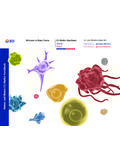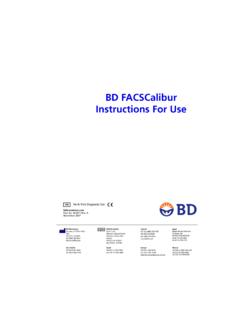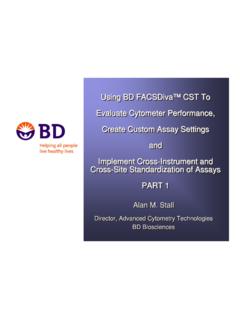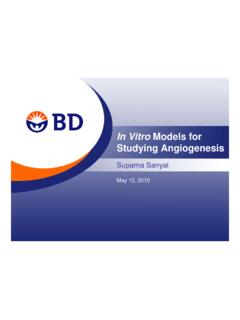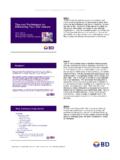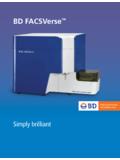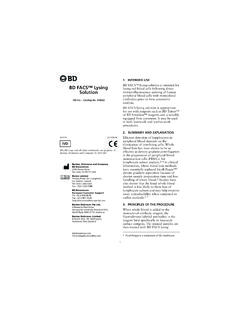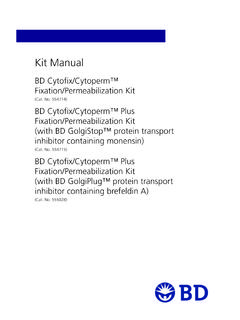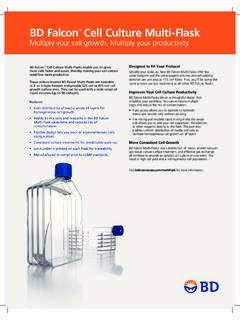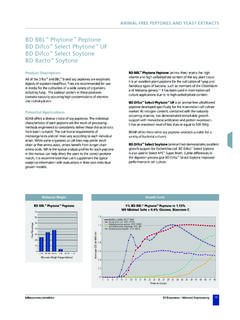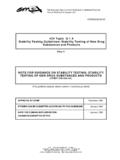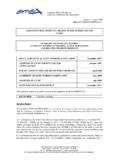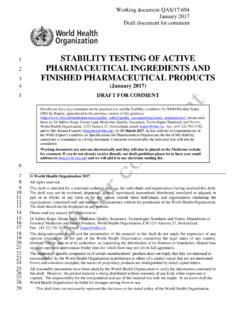Transcription of Strategies for In Vitro Metabolic Stability Testing ...
1 Strategies for In Vitro Metabolic Stability TestingChristopher Patten, PhDBD BiosciencesDecember 2, 20092 Presentation Overview Overview of in Vitro Metabolic Stability Testing In Vitro model systems and assay conditions In Vitro / in vivo Extrapolations(predicting in vivo clearance)3 Administration is oral and the drug is easily absorbed Good permeability and aqueous solubility (class I compounds) Metabolically stable (but not too stable) Swallow the pill once a day Predictable Metabolism Linear drug metabolism kinetics Balanced Clearance Renal or biliary secretion of parent drug Metabolism to limited number of inactive products Metabolism by several P450s (>2) Metabolism should not depend on Polymorphic P450s Not an Inhibitor or Inducer of ADME Enzymes P450, UGT, and MDR1 (P-gp) Small First-Pass Effect (liver or gut) Wide Therapeutic IndexThe Ideal Drug ADME/Drug Development View4 Advantages of Enhancing Metabolic Stability Increase bioavailability and half-life; less frequent dosing Improved patient compliance Better congruence between dose and plasma concentration Reduce need for therapeutic monitoring (expensive) Reduction in turnover rates from different pre-clinical species May improve extrapolations from animal data to humans Lower patient to patient variability in drug levels Patient variability largely due to differences in drug metabolism capacity Reduce the number and significance of active metabolites Reduces the need for further studies of metabolites in animals and humansAriens, et al.
2 , Strategies in Drug Research (1982)5 Timing of Metabolic Stability Testing Early Discovery HTS screens for loss of parent Determine in Vitro T1/2 Rank order compounds, SAR studies Generally test in liver microsomes from rat and human (pools) Development Determine Clintwith full Kinetics (Vmaxand Km) Use scaling factors and liver flow models to predict in vivo hepatic clearance6 Species Differences Variations in primary sequence of CYP between species can result in differences in substrate specificity/activity Levels of CYP isoforms may differ between species Interspecies differences in enzyme inhibition Cannot make cross-species predictions regarding Metabolic stability7 Sites of Drug Metabolism Primary Site of Metabolism is Liver Extra-Hepatic metabolism can be important Portals of entry tissues often have significant drug metabolism capability GI (small intestine) is major site of metabolism next to liver Other sites include: lung, skin, nasal mucosa, kidney First Pass Effect Drug absorbed in small intestine and transported to liver via portal vein Extensive metabolism in liver and/or intestine Limited systemic availability8 Bioavailability for Oral Medication (F)9 Phase I and Phase II BiotransformationMetabolism/Biotransform ation is divided into two groups Phase 1:Addition or unmasking of functional, polar moiety Oxidation (P450 or FMO) Hydrolysis (Esterases) Most typical is Hydroxyl group created or exposed (de-alkylations) Phase 2:Conjugation with small, endogenous substance, often takes advantage of functional group added in Phase I UGT is most important Phase 2 enzyme (conjugates with GA) End Result (Phase 1 + 2):Increase polarity and aqueous solubility of drug which facilitates elimination from the body10 Phase I and Phase II Drug Metabolism Enzymes in ER and CytosolNATFMOORP450 Cyt.
3 B5 UGTGSTSULTMETMETERER--LumenLumenCytosolE poxideHydrolaseLocation of UGTs causes Latency . Need to add detergent or of UGTs causes Latency . Need to add detergent or of Metabolic Enzymes11 HOOSO3 DrugMetaboliteSulfate ConjugatePhase IPhase IIRate Limiting Expose functional group that can be conjugate Small increase in hydrophilicity Large increase in hydrophilicity Conjugates are generally inactive Can be active or inactive at target site Toxic Mutagen or CarcinogenPhase I and Phase II Metabolism12 CYP3A4/5 CYP2E1 CYP2D6 CYP2C19 CYP2C9 CYP2C8 CYP2B6 CYP2A6 CYP1B1 CYP1A1/2othersepoxide hydrolaseEsterases/amidasesNQ01 DPDADHALDHCYP3A4/5 CYP2E1 CYP2D6 CYP2C19 CYP2C9 CYP2C8 CYP2B6 CYP2A6 CYP1B1 CYP1A1/2othersepoxide hydrolaseesterasesNQ01 DPDADHALDHCYP: cytochrome P450, NQ01: NADPH:quinone oxidoreductase (DT diaphorase); DPD: dihydropyrimidine dehydrogenase; ADH: alcohol dehydrogenase; ALDH: aldehyde dehydrogenaseEvans and Relling, Science (1999)Human Phase I Enzymes of Drug Metabolism13 UGTsTPMTCOMTHMTSTsGST-AGST-PGST-TGST-MNA T2 NAT1othersUGTsTPMTCOMTHMTSTsGST-AGST-PGS T-TGST-MNAT2 NAT1othersHMT: histamine methyltransferase; TPMT: thiopurine methyltransferase; COMT: catechol O-methyltransferase; UGT: Uridine Glucuronosyl-S-Transferases; ST: Sulfotransferase.
4 GST: Glutathione-S-TransferasesHuman Phase II Enzymes of Drug MetabolismEvans and Relling, Science (1999)14 Whole AnimalWhole Organ (liver)Organ SlicesCell lines (HepaRG)HepatocytesMicrosomes/S9 Expressed EnzymesPurified EnzymesUsed for Metabolic Stability TestingModel Systems for Predicting Drug Clearance In Vivo15In Vitro : Prepared from fresh human livers (organ donors) Gold-Standard for DM Studies Contain all the enzymes/transporters and co-factors for drug metabolism Metabolic Stability (Screening for long half-life drugs) Metabolite profiling (structures of metabolites) Liver toxicity studies Enzyme induction studies (P450 induction) In Vitro / In vivoscalingNot used for: Enzyme Mapping/Reaction Phenotyping Slices Similar to hepatocytes in that they contain the full complement of hepatic DMEs Harder to prepare than other systems Seldom used for ADME studies 16In Vitro Microsomes Contain all P450s, FMOs, and UGTs Easy to prepare and can be stored for long periods (-80 C) Withstand several Freeze/Thaw cycles Can make Donor Pool.
5 20 to 150 donors (average patient in population) Uses: Drug half-life (in Vitro scaling), DDI, metabolite profiles, enzyme mapping, mechanistic S9 Same as microsomes, but contains cytosolic enzymes(SULT, GST, XO, ADHs, NATs) Same advantages and uses as HLM P450 activity ~five-fold lower vs HLM17 Liver tissue1) Homogenize2) Low speed centrifugationSupernatant -S9 Pellet -- waste3) High speed centrifugationSupernatant -CytosolPellet --MicrosomesS9= Both cytosol and microsomes = Phase I & II enzymesCytosol= Soluble proteins (phase II enzymes) = NAT, GST, SULTM icrosomes= membrane proteins (phase I enzymes) = P450, UGT, FMOM ethod of Tissue Fraction Manufacture18In Vitro Enzymes ( BD Supersomes Enzymes) Single DME expressed in a cell line Baculovirus-insect cells Yeast E. coli Mammalian cells Co-expressed with P450 OR and in some cases with b5 Reaction phenotyping (EM), DDI, mechanistic studies Can be useful for studying highly stable compounds (more active than HLM) Requires RAF or ISEF for comparing to HLM activity19 CYP1A1-PhenacetinCYP1A2-PhenacetinCYP2A6 -CoumarinCYP2B6-7 EFCCYP2C8-PaclitaxelCYP2C9-DiclofenacCYP 2C19-MephenytoinCYP2D6-BufuralolCYP2E1-p -NitrophenolCYP3A4-TestosteroneCYP4A11-L auric AcidFMO-3-MTS050001000015000200002500030 000350001A11A22A62B62C82C92C192D62EI3A44 A11 FMO3 Activity (pmol/(mg min)) Comparison (per mg protein)BD Supersomes Enzymes versus HLM20 Assay Incubation Conditions Assay buffer Phosphate or Tris buffers 100 mM KPO4(pH ) with MgCl2(~3 mM) is most common Co-factors NADPH or NADPH generating system: can use either, no significant difference (GS contains MgCl2) Phase 2 co-factors: UDPGA (10 mM), PAPS (1 mM) are saturating BSA or HSA (2%)(Miners, et al.
6 , DMD, 2008) Sequesters unsaturated long chain FFA released from microsomal membranes during the course of an incubation Shown to decrease Kmfor UGT2B7, UGT1A9, and CYP2C9 (increase Clint), and improve IV-IVE predictions (FFA act as competitive inhibitors) Other CYPs and UGTs may be effected HAS need to be higher grade: HAS-FAF grade Albumin binds drugs: need to measure fu of drug in incubation UGT Reactions Alamethicin (25 ug/mL) to reduce latency (Alamethicin forms pores in microsomal membrane) Saccharic acid 1,4-lactone (5 mM) to inhibit endogenous glucuronidase activity Organic Solvents for Dissolving Test Compounds(Busby, et al., DMD, 1999) Organic solvents can inhibit P450s Acetonitrile: up to 2% Methanol: up to 1% (caution: MeOH can cause formaldehyde adducts and artifactual loss Yin, et al, 2001) DMSO: up to UGTs can also be inhibited by organic solvents Non-Specific Binding to Microsomal Membranes Test compounds can bind non-specifically to matrix (microsomes) Extent of binding is compound specific At low protein concentrations (< mg/ml) binding may be negligible Binding between HLM and rCYP are often considered the same (Stinger, et al.
7 , DMD, 2009) Protein/Cell Concentrations Hepatocytes: X 106 mL (24-well plate) Liver microsomes: mg/mL Liver S9: mg/mL cDNA-expressed enzymes: P450 activity needs to be scaled to HLM activity (RAF, ISEF), 100 pmol/ml is common21 Drug DiscoveryHTS Metabolic Stability Assays Fully automated HTS Metabolic Stability assays 384-well plate based assays (>1000 compounds/week) Reduction in assay incubation volumes: as low as 15 l (~10 g HLM per well) Loss of parent method Typically screen with rat and human liver microsomes Decrease the number of samples using sample pooling methods( cassette analysis, Halladay, et al. DM Letters, 2007) Combine with LC/MS for analysis Fast, sensitivity and selective High solvent flow rates, short columns, and column switching minimize LC run timesPredicting Drug ClearanceIn Vivo from In Vitro Data23 Drug Clearance Clearance (CL) is a measure of elimination of a drug from the body Text book definition: volume of blood cleared of drug per unit time Drug Half Life = x (Volume Distribution / CL) Determines how often you need to take a drug to achieve the desired (therapeutic) effect Clearance Mechanisms CL-met vs.
8 CL-renal vs. CL-biliary vs. CL-other CL is additive:CL (Systemic) = CLHepatic+ ClRenal+ CLBiliary+ CLOther24 Assumptions Required for Predictive Value of Microsomes Metabolism is a major mechanism of clearance CL-met >> CL-renal + CL-biliary + CL-other Liver Metabolic rate >> all other tissues Oxidative metabolism predominates P450 + FMO (UGT) >> all other Metabolic reactions In Vitro enzyme specific activity ~ in vivo enzyme specific activity25 Intrinsic Drug Clearance CLuint: enzyme-mediated clearance that would occur without physiological limitations ( protein binding, hepatic blood flow) Assumes unbound (free) drug concentrations CLuint= Vmax/Kmor (half-life) Vmax= pmol product/min*mg protein Km(Michaelis-Menten Constant) = M CLuintunits = L/min*mg microsomal protein (or # hepatocytes)26 Hepatic Scaling Factors for Whole Liver Intrinsic Clearance Microsmal SF (MSF) 40 mg microsomal protein/gr liver (Hakooz, 2006) Hepatocellularity SF 99 million cells/gr liver (Barter, 2007) Liver Weight (LW): 1400 grams Body Weight (BW): 70 kg CLuH,int= (CLuintx MSF x LW) / BW Units = L/min*kg BW (or mL/min*kg BW) Whole liver CL.
9 CLuH,intand CL forms are usedCLuH,int= CLuint(Vmax/Km)x 40mg microsome/gr liver x 1400 gr liver/kg BW27 Liver Models to Determine In Vivo Metabolic Clearance Relate drug delivery (controlled byblood flow and drug binding in blood) to the Metabolic reaction Allow for concentration differences across the liverCommon Assumptions of Liver Models Distribution into liver is perfusion rate limited and no diffusional barriers exist Only unbound drug crosses the cell membrane and occupies the enzyme site A homogenous distribution of hepatic enzymes28 Well-Stirred Model(drug-in = drug-out)Parallel-Tube Model(gradient across liver)Dispersion Model(represents the two extremes; DN)Liver Models cont. 29 Hepatic Clearance (CLH)(total body CL = ClHeptic+ ClRenal) Organ Clearance (steady state) = Q*(Cin Cout)/ Cin Q = Blood Flow C = Drug concentration Extraction Ratio (ER) = (Cin Cout)/ Cin CL = Q * ER In VivoHepatic Clearance (CLH) is predicted using a Flow Model such as the Well-Stirred (venous equilibration) Model CLH = QH* (fu*CLuH,int)/(QH+ fu*CLuH,int), with ERH= (fu*CLuH,int)/(QH+ fu*CLuH,int), and CLH= QH* ERH fu= Unbound fraction of drug (not bound to protein) Hepatic Blood Flow = ml/min*kg BW (or ~90 L/hour) Well-stirred model: assumes homogeneous distribution of drug in liver(mixed well throughout liver).
10 Drug concentration coming out of liver equals the intra-cellular drug concentration. Correcting for non-specific binding to Matrix can improve predictions (Riley et al. DMD, 2005) Measure non-specific binding directly (equilibrium dialysis devise) Estimate from octanol:water partition coefficient (Stringer et al, DMD, 2009) CLH = QH* (fu*(CLuH,int/fuinc)) / (QH+ fu*(CLuH,int/fuinc))30 Portal VeinSystemic CirculationFraction Escaping Metabolism(Bioavailability (F) = 1-EH)Fraction Metabolized (EH) QH x EH = 90 L/hour x = 81 L/hourHepatic Extraction Ratio31 Flow Limited and Capacity Limited CLH Flow Limited (high CL drugs) fu * CLuH,int>> QH CLH = QH* (fu* CLuH,int) / (fu* CLuH,int) = QH propranolol, lidocaine, morphine Capacity Limited(low CL drugs) fu * CLuH,int<< QH CLH = QH* (fu* CLuH,int) / QH= fu*CLuH,int warfarin, phenytoin, quinidine, tolbutamide Tolbutamide CL increases in hepatitis patients Due to increase in fu (no change in Clint)32 Time (X) Percent (Y)LN% = - k = (1/2) = k = (m in)Percent remaining Loss of parent method used most frequently in Discovery Stage (HTS assays) Measure disappearance of low concentration of drug (<5 or 10 M) When S << = ln2/-k (or )
